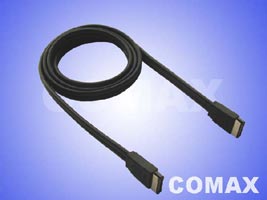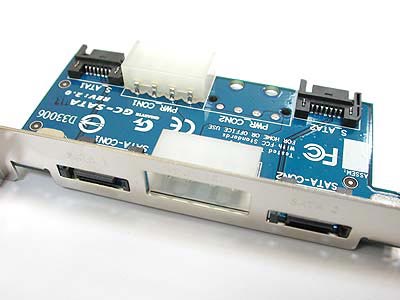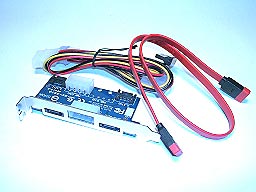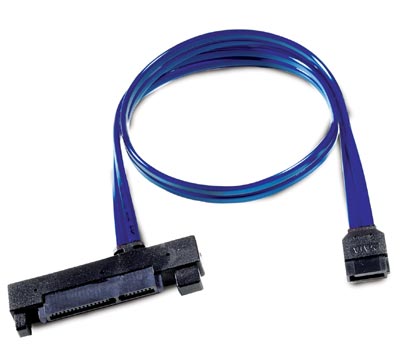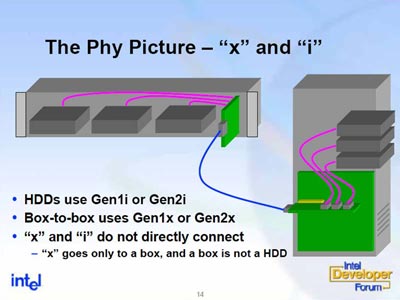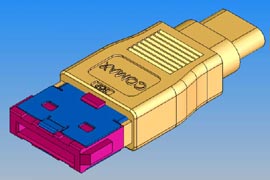External SerialATA Interface: First Facts about the Unannounced Standard
Today we are going to talk about the external SerialATA standard, its peculiarities and differences from the internal SerialATA, as well as the problems the developers may face and the solutions they offer.
by Nikita Nikolaichev
03/01/2004 | 10:37 AM
The first shy steps made by SerialATA interface have already been left in the far past. This interface started with SerialATA 1.0 specification and was intended as an alternative to the already outdated parallel ATA version.
On the way to perfection it acquired a plenty of additional features typical also of purely server components. So this year, this interface is ready to go external.
It is true, the decision to standardize SerialATA as a universal port for external and internal drives was natural: the speed characteristics of the interface (even the very first versions provided up to 150MB/sec), noise immunity of the interface cable, simple layout and other parameters had to push the SATA developers to this decision one day. And then the overwhelming popularity of the external drives came, with its eternal competition of USB and FireWire interfaces. Although both of them are negligible if compared to SerialATA. For instance, the latest interface versions ensure the following performance levels: USB 2.0 – 480Mbit/sec and FireWire (IEEE1394b) – up to 800Mbit/sec, while SerialATA 1.0 should theoretically be able to provide 1.5Gbit/sec.
The first presentation of the official standard specifications was supposed to take place at the spring IDF 2004 in San Francisco. Although there shouldn’t be any sensation as the mere idea of external devices support has already been implied during the development of this standard, though it is only now that they finally got down to its implementation. The first working demo samples of the external SerialATA interface were displayed at the IDF Fall 2003 at the booths of Maxtor, Silicon Image and Comax Companies and were based on the draft specs presented by SATA II Working group (SerialATA II Cables and Connectors Volume 2). They used Maxtor DiamondMax SATA HDD, PCI-SATA Sil 3112 SATALink bridge and a prototype of an external screened SATA cable from Comax.
The major details about the external SATA standard are available in the presentation called “Knut Grimsrud - Intel, Serial ATA 3 Gbps and Next Frontier”, which was made on September 18, 2003 during the Intel Developer Forum, or in the book by the same Knut Grimsrud called “Serial ATA Storage Architecture and Applications: Designing High-Performance, Cost-Effective I/O Solutions”, which you can browse through or even purchase in the Internet today. If you take a closer look at one of the slides from the last year’s presentation, you will notice a mention of the external Serial ATA versions and their clear definition:
The first generation of SATA interface marked as Gen1, namely its two existing versions – Gen1i and Gen1m (they actually differ by the signal levels) supports only internal devices, just like the first modification of the second generation Gen2i interface. However, the modifications marked as Gen1x/Gen2x are exactly the external implementations of the SerialATA.
Now let’s set all the major questions, which determine the peculiarities of the external SerialATA interface implementation.
The principles implied by the very first specifications of the physical SerialATA are known to allow using the signal interface SerialATA cable up to 1 meter long and connecting an external device to it. HighPoint Company has been a supplier of pseudo SerialATA external controllers and drives, and all last year they were improving their e.SATA product line. Among these e.SATA devices from HighPoint there are separate controller cards, as well as packages including controllers, cables and the corresponding external drives. The advantages provided by the RocketRAID 1542 PCI card are more than evident, because with this card installed the user gets 4 SATA channels (2 internal and 2 external ones) with hot swap and RAID 0, 1, 0/1, JBOD support for Windows 9x/ME/NT4.0/2000XP, Red Hat, SuSE, Turbo, Caldera Linux and FreeBSD. Those of you, who already have a mainboard with the integrated SerialATA controller, can get a simple package from highpoint, including a bracket for the external SerialATA cable.

Another version of the SATA support implementation has been suggested by Gigabyte Company. They supply some of their mainboards with an additional cable and a special bracket with the laid out two SerialATA connectors and a power supply connector.
It is a pity but the new approach is not controlled by the standard and the proper performance of the package is totally within the manufacturer’s responsibility when we are talking about a non-standard device like that. As an example of the problems you might encounter when you connect external devices via the internal SerialATA version I could mention at least the fact that the standard warns against moving and shaking the interface cable during work. The acceptable signal level for internal devices and the cable screening requirements cannot ensure the desired protection against noises and distortions when you work with an external device. And the relatively weak connector used for internal solutions is beyond any criticism at all, if you decide to use it for external storage drives.
All these things push you to the conclusion that external SerialATA requires different signal levels and a longer and better screened interface cable with a completely different secure connector.
External Cable Length and Features
To be fair I should say that high-quality screened cable will be a nice addition to the internal SATA devices, too. One of the first developers, who paid serious attention to cables and their characteristics, appeared Western Digital Company, which is also shipping their own cable to the market today: WD SecureConnect:
The requirements listed in the “Serial ATA II Cables and Connectors Volume 2” specifications say that the cable for external SATA devices shouldn’t be longer than 2 meters and the cable itself should contain an additional integrated signal channel responsible for coordination of up to four external devices. This serial connection scheme is expected to be the most demanded for industrial and server devices, such as RAID subsystems, for instance.
The connectors for external SerialATA devices have also undergone serious changes. In order to improve the protection against EMI (ElectroMagnetic Interference) and ESD (ElectroStatic Discharge) the developers paid special attention to proper screening. The requirements to mechanical specifications of the connectors have also grown tougher. The diversity of cables and connectors of the new type is determined by the above mentioned support of the multi-channel interfaces.
A part of the specification related to the multi-channel connection of external devices, hasn’t been disclosed yet. However, the new standard requirements will be based on the SFF-8470 (Small Form Factor 8470) specification, which has been developed and applied for InfiniBand and Fibre Channel solutions. By the way, similar solutions were developed and will be implemented for more serious and demanding Serial Attached SCSI standard. In this respect, I would call the external SerialATA devices support a preliminary set of questions set and solved for the further use for Serial Attached SCSI standard.
According to the info, which has already been submitted by Comax Technology Company, which produces cables and also works on the standard, the requirements to SerialATA cables look as follows:
| Chanel bandwith | Max cable length | |
|---|---|---|
| 1 chanel |
|
|
| 2/4 channels |
|
|
| 1 external channel |
|
|
| Several ext. channels |
|
|
Although, there is no problem at all with the production technology for cables intended for external SATA devices. Despite high standard requirements, you can already see a few types of such cables on Comax Technology site. And the company guarantees that its products cab ensure up to 4.5Gbit/sec bandwidth.
Unfortunately, unlike a more flexible USB standard, external SATA cables are purely informational interfaces, the drives will be powered separately, which is not determined by the standard. All the other interesting stuff, including the first samples of the new standard could be seen during the IDF Spring 2004.

